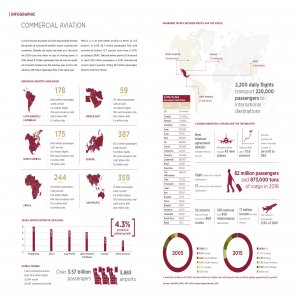Grow Locally to Weather Foreign Pressures

STORY INLINE POST
Mexicans welcomed the year 2017 with a rough start, which resulted in many challenges for both citizens and the economy. A weakening peso and higher gas prices put a particular pall over aviation. Magnicharters felt the heat but a renovation strategy is expected to help the local airline come out on top. Jorge Badía, the company’s Operations Director, says the new landscape will lead to growth of the local and regional markets.
“Raising ticket prices will lead to a reorganization of the market. Those who traveled internationally will travel locally, many who used to travel in business and first class will travel in economy,” says Jorge Badía, Operations Director of Magnicharters. “This reorganization will extend to national and international routes, as a strong dollar discourages Mexican passengers from traveling further afield, and will promote domestic travel to other destinations in Latin America.”
In January, the exchange rate surpassed MX$20 per dollar and gasoline prices shot up due to the removal of government subsidies in what Mexicans called the gazolinazo. The rise in fuel prices can impact airlines as jet fuel represents an average of 30 percent of operational costs. Furthermore, while Mexican airlines charge passengers in pesos all services and parts are valued in dollars. The dollar-peso exchange rate will bring about higher prices for airlines, which will eventually be reflected in the cost of tickets.
Mexican airlines face another challenge: the Bilateral Aviation Safety Agreement (BASA) between Mexico and the US. Ratified last year, this agreement was met with mixed reception by local airlines. “Opening the market up to competition is a positive sign but the US greatly surpasses Mexico in number of aircraft,” says Badía. So far, international airlines dominate the global market. According to the Ministry of Transportation (SCT), of the 39.1 million passengers that flew internationally, 27.6 million flew with an international carrier. Allowing more airlines to enter the market may make it harder for Mexican airlines to compete but, according to Badía, “the full impact of BASA has not been apparent. Some airlines are now able to travel to destinations they could not before. But new foreign airlines will not be able to fly to Mexico City until NAICM is finished.”
Magnicharters is not deterred by these challenges. To face them, the company is fortifying its focus on local destinations and is increasingly looking toward Central and South America. The airline is developing more domestic routes and routes south of Mexico, and inaugurated a direct flight to Punta Cana in July. “The advantage of operating solely within Latin America, besides potentially lower prices, is a similar culture throughout and a shared language,” says Badía.
As the company implements its consolidation plan, it will renovate its entire fleet and reduce operational costs to boost efficiency. “Our own reorganization will comprise many steps, as we must eliminate superfluous costs and common errors. For instance, a 10-minute delay incurs extra costs from the extended use of the airport’s infrastructure and delays other flights, but the cost in public perception is even higher.” Optimizing flights is to everyone’s benefit, as a delay at Mexico City’s airport is felt by every arriving or departing flight and carried on to other airports.
The airline uses travel agents as its main sales force, a remarkable concept in an era where most companies are betting on search platforms to increase their online sales. Now, the company is analyzing its marketing strategy to increase its online presence without changing its existing alliance with travel agents. “Online sales are quickly gaining strength but in my opinion Mexicans still prefer to use travel agents,” says Badia, remarking that one-on-one interactions allow for a closer and more fulfilling relationship with clients.
While Magnicharters kept a sustained operational rhythm in 2016, they did feel the effects of a slowdown in the sector. “Although 2016 was hard, we are satisfied with our results and we hope our new route offering will lead us to growth.” For 2017, Magnicharters will continue to prioritize customer service through its vast travel agent network as it aims to increase efficiency and generate more routes and products for its passengers.
























